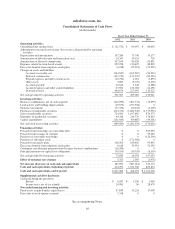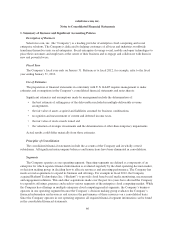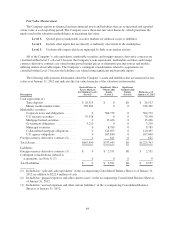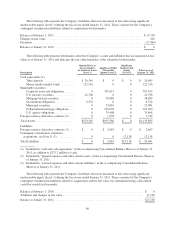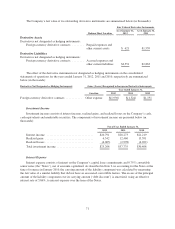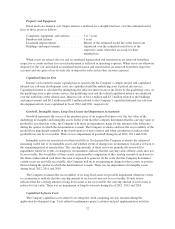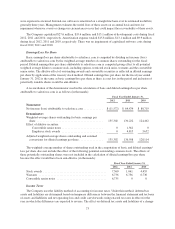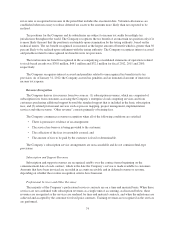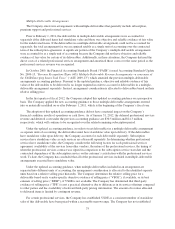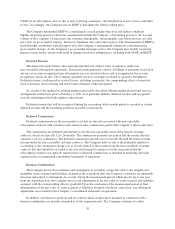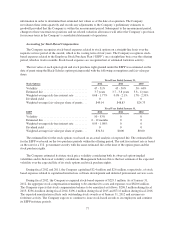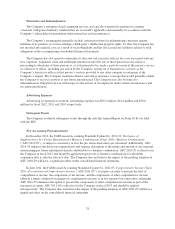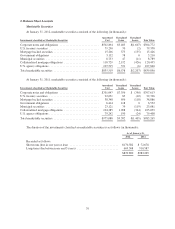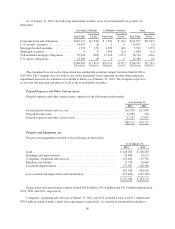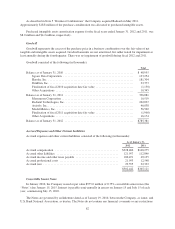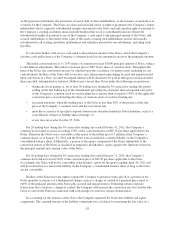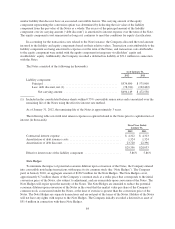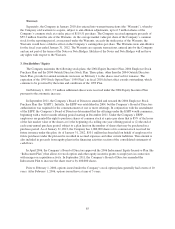Salesforce.com 2012 Annual Report Download - page 79
Download and view the complete annual report
Please find page 79 of the 2012 Salesforce.com annual report below. You can navigate through the pages in the report by either clicking on the pages listed below, or by using the keyword search tool below to find specific information within the annual report.Multiple-Deliverable Arrangements
The Company enters into arrangements with multiple-deliverables that generally include subscription,
premium support and professional services.
Prior to February 1, 2011, the deliverables in multiple-deliverable arrangements were accounted for
separately if the delivered items had standalone value and there was objective and reliable evidence of fair value
for the undelivered items. If the deliverables in a multiple-deliverable arrangement could not be accounted for
separately, the total arrangement fee was recognized ratably as a single unit of accounting over the contracted
term of the subscription agreement. A significant portion of the Company’s multiple-deliverable arrangements
were accounted for as a single unit of accounting because the Company did not have objective and reliable
evidence of fair value for certain of its deliverables. Additionally, in these situations, the Company deferred the
direct costs of a related professional services arrangement and amortized those costs over the same period as the
professional services revenue was recognized.
In October 2009, the Financial Accounting Standards Board (“FASB”) issued Accounting Standards Update
No. 2009-13, “Revenue Recognition (Topic 605), Multiple-Deliverable Revenue Arrangements—a consensus of
the FASB Emerging Issues Task Force” (“ASU 2009-13”) which amended the previous multiple-deliverable
arrangements accounting guidance. Pursuant to the updated guidance, objective and reliable evidence of fair
value of the deliverables to be delivered is no longer required in order to account for deliverables in a multiple-
deliverable arrangement separately. Instead, arrangement consideration is allocated to deliverables based on their
relative selling price.
In the first quarter of fiscal 2012, the Company adopted this updated accounting guidance on a prospective
basis. The Company applied the new accounting guidance to those multiple-deliverable arrangements entered
into or materially modified on or after February 1, 2011, which is the beginning of the Company’s fiscal year.
The adoption of this updated accounting guidance did not have a material impact on the Company’s
financial condition, results of operations or cash flows. As of January 31, 2012, the deferred professional services
revenue and deferred costs under the previous accounting guidance are $30.5 million and $14.3 million,
respectively, which will continue to be recognized over the related remaining subscription period.
Under the updated accounting guidance, in order to treat deliverables in a multiple-deliverable arrangement
as separate units of accounting, the deliverables must have standalone value upon delivery. If the deliverables
have standalone value upon delivery, the Company accounts for each deliverable separately. Subscription
services have standalone value as such services are often sold separately. In determining whether professional
services have standalone value, the Company considers the following factors for each professional services
agreement: availability of the services from other vendors, the nature of the professional services, the timing of
when the professional services contract was signed in comparison to the subscription service start date and the
contractual dependence of the subscription service on the customer’s satisfaction with the professional services
work. To date, the Company has concluded that all of the professional services included in multiple-deliverable
arrangements executed have standalone value.
Under the updated accounting guidance, when multiple-deliverables included in an arrangement are
separated into different units of accounting, the arrangement consideration is allocated to the identified separate
units based on a relative selling price hierarchy. The Company determines the relative selling price for a
deliverable based on its vendor-specific objective evidence of selling price (“VSOE”), if available, or its best
estimate of selling price (“BESP”), if VSOE is not available. The Company has determined that third-party
evidence of selling price (“TPE”) is not a practical alternative due to differences in its service offerings compared
to other parties and the availability of relevant third-party pricing information. The amount of revenue allocated
to delivered items is limited by contingent revenue.
For certain professional services, the Company has established VSOE as a consistent number of standalone
sales of this deliverable have been priced within a reasonably narrow range. The Company has not established
75


